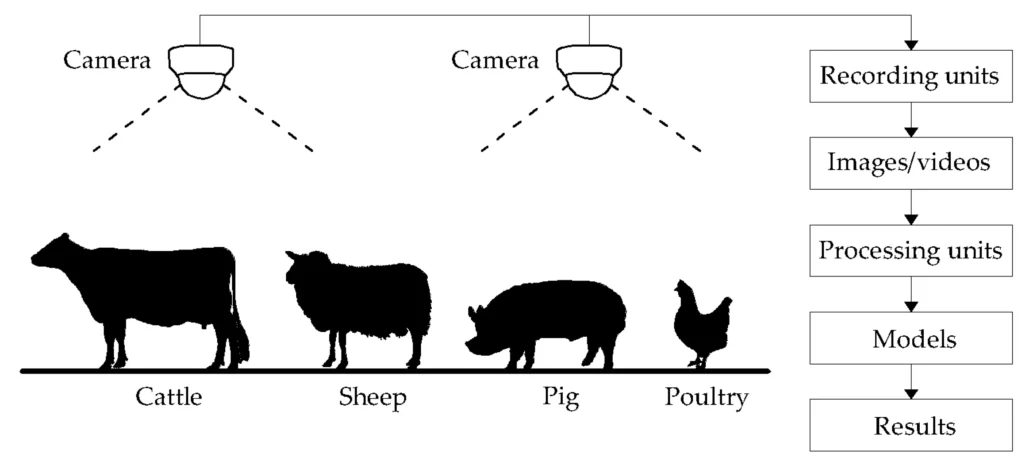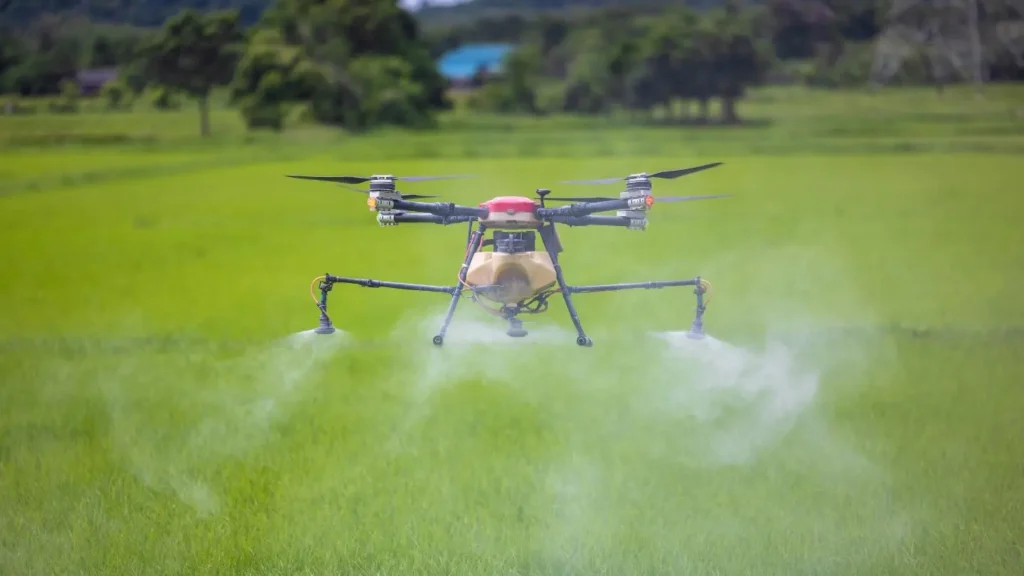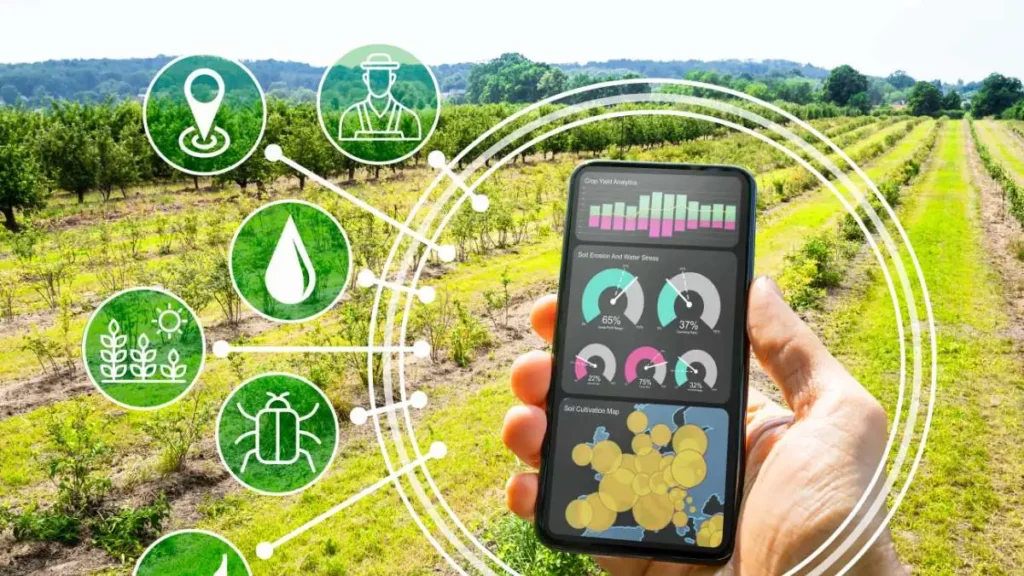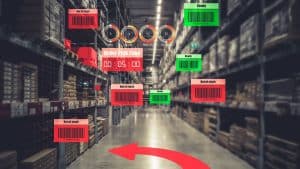Farming might be one of the oldest trades in the world. Yet emerging technologies are turning agriculture into an exact science.
You can transform agriculture with computer vision by using drones for crop monitoring and precision soil analysis, guaranteeing peak health and efficient resource allocation.
Early disease detection becomes straightforward with high-resolution imaging, enabling timely interventions. For livestock, computer vision aids in monitoring health and predicting behaviors to boost productivity.
During harvesting, intelligent systems ensure accurate crop picking and quality assessments. Advanced algorithms classify and grade crops swiftly, maintaining market standards.
It is just a few examples, let’s take a look how the latest technologies make farming more productive, efficient and less labor intensive further ahead.
Key Takeaways
- Drones with high-definition cameras enable real-time crop monitoring and soil condition analysis.
- AI-driven systems allow early disease detection and targeted fungicide application.
- Precision crop picking and automated harvesting improve efficiency and productivity.
- Machine vision systems automate crop sorting, grading, and logistics with high accuracy.
- Real-time surveillance enhances farm security by detecting intrusions and unauthorized activities.
Crop Monitoring With Drones


Harnessing drone technology for crop monitoring transforms the way you can assess crop health, soil conditions, and farmland mapping with unparalleled speed and accuracy. By leveraging drones equipped with high-definition cameras and advanced computer vision capabilities, you achieve a holistic understanding of your agricultural landscape. This technology is a cornerstone of precision agriculture, allowing you to monitor vast areas quickly and effectively.
With drones, you can perform real-time crop monitoring, detecting subtle changes in plant health that might be invisible to the naked eye. High-definition cameras capture detailed images that, when processed through computer vision algorithms, provide insights into plant vigor, nutrient deficiencies, and hydration levels. These insights enable you to make data-driven decisions that optimize crop yields and resource use.
Moreover, drones equipped with these technologies can monitor soil conditions by analyzing color variations and texture, helping you identify areas needing intervention. Farmland mapping becomes more precise, with drones covering large expanses swiftly, creating detailed maps that highlight crop areas and potential issues.
Essentially, drones enhance your ability to maintain crop health, improve soil management, and maximize efficiency, fundamentally transforming modern agricultural practices.
Disease Detection
Building on the capabilities of drones in crop monitoring, computer vision technology excels in early disease detection by analyzing visual cues and patterns in plant health. By capturing high-resolution images and utilizing sophisticated algorithms, you can identify subtle changes in leaf coloration, texture, and morphology that indicate the presence of plant disease long before it becomes visible to the naked eye. This early detection allows you to intervene promptly, potentially saving entire fields from devastating outbreaks.
Real-time monitoring is pivotal in disease detection. With the integration of computer vision in agriculture, you get continuous surveillance of your crops, enabling immediate identification and response to emerging threats. Algorithms process the data on-the-fly, flagging any anomalies that suggest disease, which means you don’t have to wait for manual inspections or lab results. This proactive approach minimizes the spread of pathogens and optimizes the use of fungicides, reducing both costs and environmental impact.
Moreover, computer vision systems can differentiate between various plant diseases, providing you with precise diagnoses. This specificity helps in tailoring the treatment plans to the exact needs of your crops, ensuring more effective disease management and healthier yields.
Weed detection and management


Computer vision technology enhances weed management by accurately distinguishing between crops and weeds, enabling targeted herbicide application and reducing chemical usage. By integrating high-resolution cameras and advanced algorithms, you can achieve precise crop monitoring. This technology identifies and classifies different plant species in real-time, guaranteeing that only the weeds are treated with herbicides.
Through targeted herbicide application, you minimize the amount of chemicals used, which not only cuts costs but also benefits the environment. Additionally, this thoroughness reduces the risk of herbicide resistance among weed populations. Computer vision systems can be mounted on tractors or drones, providing extensive field coverage and consistent monitoring.
Furthermore, when combined with disease detection capabilities, this technology offers holistic crop management. Early identification of diseases and weeds allows you to intervene promptly, maintaining the health and yield of your crops. This integrated approach ensures that resources are allocated efficiently, and crop health is optimized.
Harvesting automation
At its core, utilizing computer vision in harvesting automation allows for precise and efficient picking of crops, markedly reducing labor costs and post-harvest losses. By integrating computer vision technology, you can automate the identification and selection of ripe produce, ensuring only the best quality crops are harvested. This technology leverages high-resolution cameras and sophisticated algorithms to analyze visual data in real-time, making split-second decisions that maximize yield and quality.
Incorporating computer vision into your harvesting operations means that you can achieve consistent crop monitoring throughout the growing season. This constant surveillance enables early disease detection and effective weed management. Imagine your system identifying unhealthy plants or invasive weeds and taking corrective action before these issues escalate, thereby safeguarding your crops and optimizing resource use.
Furthermore, automated harvesting systems can adapt to varying crop types and conditions, offering flexibility and scalability. They minimize human error and physical strain, allowing your workforce to focus on more strategic tasks. By embracing these advancements, you not only streamline harvesting but also enhance overall agricultural productivity.
Essentially, computer vision technology transforms the harvesting process into a more intelligent, efficient, and sustainable operation.
Livestock Farming


Integrating computer vision into livestock farming enables precise monitoring of animal health and behavior, optimizing herd management and welfare. You can use computer vision technology to track individual animals, identifying early signs of illness and stress through image analysis. This allows for timely interventions, reducing the spread of disease and improving overall herd health.
Precision livestock farming leverages this technology to monitor weight, movement, and feeding patterns. By analyzing these factors, you can adjust farming practices to enhance productivity and animal welfare. For instance, image analysis can detect abnormal gait patterns, indicating lameness, which would otherwise go unnoticed until it’s severe.
Moreover, computer vision enhances biosecurity measures. By continuously monitoring livestock, you can immediately identify and isolate sick animals, preventing potential outbreaks. This proactive approach minimizes economic losses and enhances the sustainability of your farming operations.
Additionally, the technology aids in reproductive management. By monitoring behavior, you can predict the best breeding times, thereby increasing reproductive success rates.
Implementing computer vision in livestock farming not only streamlines operations but also ensures that animal welfare is prioritized, leading to a more efficient and humane farming practice.
Yield estimation
By leveraging high-resolution imaging and sophisticated algorithms, yield estimation in agriculture becomes more accurate and efficient. You can use computer vision-based techniques to analyze images of crops, providing a detailed view of plant health, growth stages, and potential yield. High-resolution cameras capture intricate details, which are then processed by algorithms to generate data-driven insights.
Yield prediction involves evaluating factors like plant height, leaf area, and fruit count. These variables are essential for estimating crop yield. By processing images captured at various growth stages, you can predict the final yield with a high degree of accuracy. This approach minimizes the guesswork traditionally involved in yield estimation.
Computer vision-based yield estimation enables you to make informed decisions regarding resource allocation. For example, you can adjust irrigation, fertilization, and pest control measures based on the predicted yield, optimizing overall crop management. Additionally, these insights help you plan harvest schedules more effectively, ensuring that crops are picked at their peak.
Incorporating data-driven insights from high-resolution cameras into your yield prediction strategy not only enhances accuracy but also improves efficiency. This technology empowers you to maximize crop yield, reduce waste, and ultimately increase profitability.
Soil health analysis


Computer vision technology in agriculture is transforming soil health analysis through the capture and processing of high-resolution images. These images provide valuable insights into soil composition, moisture levels, and nutrient content, enabling more precise crop monitoring and proactive management strategies. High-resolution imaging allows for the early detection of nutrient deficiencies, ensuring timely corrective actions to maintain crop yields.
Soil health analysis also plays a crucial role in enhancing disease detection capabilities. Healthy soil supports robust plant growth, reducing crop susceptibility to diseases. By identifying areas with poor soil health, farmers can pinpoint potential disease hotspots and implement targeted interventions. Furthermore, understanding soil composition and moisture levels facilitates effective weed management. This knowledge makes it easier to differentiate between crop plants and weeds, enabling targeted herbicide application and reducing overall chemical use.
Computer vision phenotyping
While soil health analysis provides the foundation for robust plant growth, computer vision phenotyping advances agricultural research by accurately measuring and analyzing plant characteristics to optimize breeding and cultivation practices.
Traditionally, phenotyping involved labor-intensive manual measurements, but now, AI-driven computer vision systems have transformed this field. These technologies can capture high-resolution images and analyze vast datasets, providing precise insights into plant growth, health, and genetic traits.
In agriculture, computer vision phenotyping enables you to monitor plant characteristics such as leaf size, shape, color, and growth patterns. By using advanced algorithms, farmers and researchers can identify traits that contribute to higher yields and disease resistance. This data-driven approach allows for the selection of the most resilient and productive plant varieties, essential as climate change presents new challenges.
Moreover, computer vision phenotyping helps you understand which environmental conditions best support specific crops, optimizing resource allocation and improving sustainability. This technology not only enhances the resilience of plants but also supports precision agriculture by providing actionable insights that lead to better decision-making processes.
Ultimately, integrating computer vision and AI in phenotyping is transforming how we cultivate and breed plants, making agriculture more efficient and sustainable.
Pesticide spraying with drones


Leveraging drones for pesticide spraying transforms crop protection by combining speed, precision, and safety, greatly reducing the risks and inefficiencies associated with manual application. Drones equipped with computer vision technology can identify specific areas infested with pests and diseases, allowing for targeted pesticide application. This pivotal approach ensures that only the necessary amount of chemicals is used, minimizing environmental impact and reducing costs.
The speed at which drones operate is a significant advantage. Traditional methods of pesticide spraying are labor-intensive and time-consuming, but drones can cover large areas swiftly and efficiently. This rapid deployment is essential during peak pest seasons when timely intervention can save crops from extensive damage.
Precision is another key benefit. With high-resolution cameras and advanced algorithms, drones can detect even the smallest signs of infestation. Computer vision enables the drones to differentiate between healthy and affected areas, ensuring that pesticides are applied only where needed. This precision reduces chemical overuse, preserving soil health and preventing crop damage.
Moreover, using drones for pesticide spraying enhances safety. Farmers aren’t exposed to harmful chemicals, reducing health risks. Overall, drones integrated with computer vision represent a game-changing advancement in agricultural practices.
Crop sorting and grading
Efficiently sorting and grading crops, machine vision systems drastically reduce the time and labor required for these repetitive tasks. With advanced image classification algorithms, these systems can detect and sort various crop types swiftly and accurately. For instance, they can differentiate between large and medium-sized potatoes, meeting specific order requirements within moments. This level of precision in crop sorting guarantees that the output meets market standards consistently.
In terms of crop grading, machine vision systems excel in evaluating the quality of produce. They can identify defects, blemishes, and ripeness levels in fruits and vegetables through sophisticated fruit detection techniques. This automated grading not only speeds up the process but also maintains a high level of accuracy, thereby improving the overall quality control.
Additionally, machine vision systems can prioritize products based on perishability. By sorting batches to be shipped first according to their shelf life, these systems optimize logistics and reduce waste.
Whether it’s counting apples directly from trees or sorting them based on quality, machine vision systems employ cutting-edge technology to innovate agricultural efficiency. Through these advancements, farmers can focus on more strategic tasks, knowing that their crop sorting and grading are in capable hands.
Security monitoring for remote farms
Real-time surveillance systems equipped with AI algorithms bolster security measures for remote farms by detecting intrusions and identifying anomalies with high precision. These advanced surveillance systems utilize high-resolution cameras and deep neural networks to monitor farm perimeters continuously. By processing images through AI algorithms, the systems can discern between normal activities and potential security threats almost instantaneously.
For remote farms, where human oversight may be sporadic, security monitoring is vital. AI-driven surveillance systems can perform reliable face recognition, even under varying lighting conditions, ensuring that unauthorized individuals are promptly identified. This level of precision reduces false alarms and enhances the farm’s overall security infrastructure.
Deploying such systems helps you maintain a secure environment, mitigating risks of theft or vandalism, which are prevalent in isolated agricultural locations. The AI algorithms not only detect human intrusions but can also identify other anomalies, such as unusual animal movements or equipment malfunctions, providing a thorough security solution.
Frequently Asked Questions
Conclusion
By integrating computer vision in agriculture practices, you’re not just guaranteeing the best use of resources—you’re leading the way to a smarter, more efficient future. You’ll detect diseases early, manage weeds precisely, and even automate harvesting.
This technology guarantees efficient resource use, boosts crop quality, and promotes sustainability. Embrace these advancements to transform your farm into a high-performing, data-driven operation.
Your journey toward transforming agriculture starts now. Ready to step into the future of agriculture?
Do get in touch.
Curious About The Above Solution?
Chat with Vejūnė and explore your possibilities without any commitment.


Vėjūnė Krašinskienė
Chief Operating Officer
Book a no-obligation free consultation with our expert.



